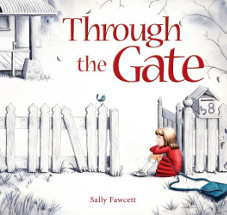Through the gate by Sally Fawcett

EK Books, 2017. ISBN 9781925335415
As she looks through the gate of her new house, the little girl is
feeling really despondent because it is anything but new. All she
could see were the drooping roof, the peeling paint, and the
crumbling steps. As she sits on the step pondering all the changes
of a new house, a new town and a new school she sees nothing bright
in her future. But gradually, slowly, one step at a time things
begin to change - and so does she.
This is a familiar story for many children who are uprooted from
their comfort zone that has been told on so many different levels
that it is quite brilliant.
Firstly there is the concept - as the house is slowly restored to
something smart and vibrant so does her mood and her willingness to
look beyond her untied shoelaces, gradually lifting her head to the
possibility and potential that surrounds her. Then there is the text
itself - carefully chosen vocabulary that reflects the girl's moods,
changing with each step forward that she takes in settling into her
new environment. This is accompanied by illustrations that have an
increasing use of colour and detail, climaxing in full-colour
spreads as the future becomes clearer. And throughout, the changes
are reflected in the life of the little bird that first appears on
the front endpaper as a lonely soul with a forlorn twig and ends on
the back endpaper showing all the riches of life.
This is a story about nothing staying the same; about even the most
dismal day waking to a sunrise soon; about how our moods and
feelings can colour our world; and cliches like 'light at the end of
the tunnel'; 'some days are diamonds and some days are stones' and
'without rain there can be no rainbows.' While younger readers may
engage on a more superficial level at spotting the changes to the
house and the bird's business, older readers may be able to dig
deeper and look at the more philosophical ideas that underpin the
story as well as learning about looking for the positive, managing
emotions and expectations, and developing strategies that will help
them deal with new, tough or confusing situations, physical or
emotional. Some might even like to share such occasions and how they
coped perhaps sending a message to other classmates that they are
not alone and not on their own.
Change can be challenging but time can take care of things.
Extensive teaching
notes are available.
Barbara Braxton